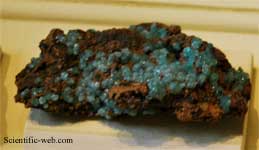| - Art Gallery - |
Adamite is a zinc arsenate hydroxide mineral, Zn2AsO4OH. It is a mineral that typically occurs in the oxidized or weathered zone above zinc ore occurrences. Pure adamite is colorless, but usually it possess yellow color due to Fe compounds admixture. Tints of green also occur and are connected with copper substitutions in the mineral structure. Olivenite is a copper arsenate that is isostructural with adamite and there is considerable substitution between zinc and copper resulting in an intermediate called cuproadamite. Zincolivenite is a recently discovered mineral being an intermediate mineral with formula CuZn(AsO4)(OH). Manganese, cobalt, and nickel also substitute in the structure. An analogous zinc phosphate, tarbuttite, is known. The yellow to bright lime-green colored crystals and druze along with its distinctive fluorescence make adamite a favorite among mineral collectors. Found in Mapimi, Mexico; Greece; and California and Utah in the United States. Adamite was named after the French mineralogist Gilbert Joseph Adam (1795-1881). The type locality is in the Atacama Desert in Chile. * A comprehensive list of minerals References
Retrieved from "http://en.wikipedia.org/"
 |
|
|||||||||||||||||||||||||||||||||||||||||
